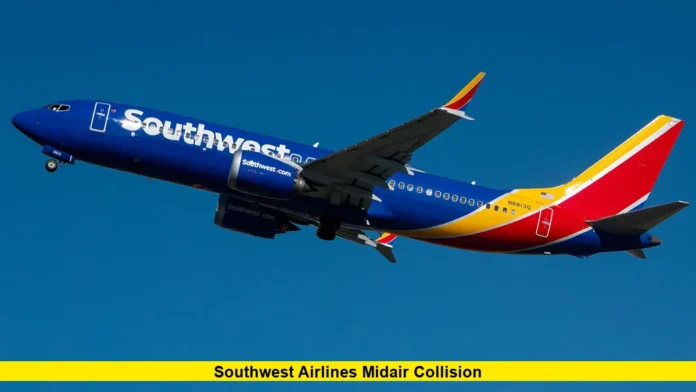Southwest Airlines midair collision nearly occurred during Flight 1496’s journey from Hollywood Burbank to Las Vegas, sending shockwaves through passengers and triggering a federal safety review.
Just minutes after takeoff on July 25, 2025, passengers aboard the Boeing 737 experienced a terrifying drop of nearly 500 feet in under a minute. The aircraft had just reached an altitude of over 14,000 feet when its collision alert system issued two separate warnings. Reacting swiftly, the pilots executed both a brief climb and an abrupt descent to avoid a potential crash with another aircraft flying nearby.
According to passengers, the sudden dive was chaotic. Many unbuckled travelers were thrown into the air, and several items inside the cabin scattered violently. Two flight attendants were injured during the drop, while passengers, though shaken, escaped without serious harm.
Table of Contents
What Led to the Sudden Dive?
Initial reports indicate that the near miss was with a privately operated jet aircraft flying at roughly the same altitude. The two planes came dangerously close to one another, prompting the 737’s Traffic Collision Avoidance System (TCAS) to initiate emergency maneuvers.
The descent happened approximately six minutes after takeoff. Data shows that the plane dropped from 14,100 feet to 13,625 feet in a matter of seconds. Though the descent was controlled, passengers described the moment as a “free fall.”
Airline and FAA Reactions
Southwest Airlines has confirmed the incident and praised the crew’s rapid response under pressure. The airline stated that the pilots followed established safety protocols in response to the automated collision alerts.
The Federal Aviation Administration (FAA) has launched a full investigation into the incident, focusing on why two aircraft were allowed to come into such close proximity. Officials are also reviewing air traffic control communication logs to determine if any directives or warnings were delayed or miscommunicated.
Recent String of Airspace Incidents Raises Concerns
This event follows a series of recent close calls in U.S. airspace that have alarmed both officials and travelers. Earlier this month, a regional flight in the Midwest had to quickly maneuver away from a military aircraft during a routine flight path. In January, a tragic midair collision between a commercial jet and a helicopter resulted in dozens of fatalities, renewing calls for stricter airspace coordination.
Experts point to increasing congestion in American skies and occasional lapses in air traffic control as contributing factors. With both private and commercial aviation traffic on the rise, the need for better separation protocols is becoming more urgent.
Timeline of the Incident
| Event | Details |
|---|---|
| Date | July 25, 2025 |
| Flight | Southwest Airlines Flight 1496 |
| Route | Hollywood Burbank to Las Vegas |
| Altitude at Warning | 14,100 feet |
| Altitude Drop | ~475 feet in under 1 minute |
| Injuries | 2 flight attendants (non-life-threatening) |
| Collision Avoidance Trigger | Two TCAS alerts |
| Aircraft Involved | Boeing 737 and unidentified jet |
Passenger Reactions
Passengers on board were visibly shaken. Some described it as the most terrifying flight of their lives. According to firsthand accounts, those not wearing seat belts were lifted from their seats and hit the cabin roof before falling back down. The sudden movement caught many off guard, with some screaming and others bracing for impact.
Despite the chaos, the flight landed safely in Las Vegas. Medical staff greeted the plane on arrival, assisting the injured crew members.
What’s Next?
The FAA will continue its investigation in coordination with Southwest’s internal safety team. Authorities are working to identify the second aircraft involved and determine if its operators followed proper flight regulations.
For now, Southwest has not grounded any flights related to this incident, but internal briefings have been issued to flight crews, emphasizing heightened alertness during climb and cruise phases.
This incident serves as another stark reminder of the importance of airborne collision warning systems and crew preparedness. Without the aircraft’s onboard technology and the pilots’ swift action, the situation could have ended in disaster.
Stay tuned as more details are expected in the coming days, and let us know your thoughts on what should be done to improve air travel safety.
